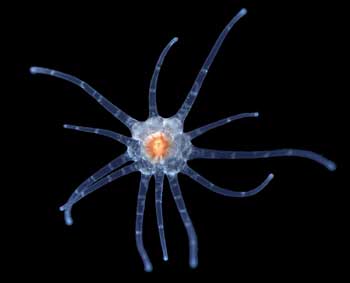Sea anemone genome provides insight on evolution
Sea anemone genome provides insight on evolution
mongabay.com
July 5, 2007
The sea anemone genome is far more complex and vertebrate-like than the fruit fly or nematode genomes, reports a study published in the July 6th issue of the journal Science. The analysis provides insights into the common ancestor of nearly all multi-celled animals, including humans.
Studying the genome of the starlet sea anemone (Nematostella vectensis), a small animal found in brackish water along the east and west coasts of the United States and in the British Isles, researchers found that “the last ancestor shared by almost all living animals actually possessed a relatively complex genome with many of the genes previously thought to be unique to vertebrates.”
“We are looking close to the base of the animal tree of life,” said Daniel Rokhsar of the University of California at Berkeley’s Center for Integrative Genomics and leader of the research team. ” What was the common ancestor of all animals like” What did it eat” Did it have muscles” a brain” Comparing genomes is a way of looking back in time to infer features of the ancestral genetic blueprint for animals.”

The slit-shaped mouth of the Nematostella breaks the radical symmetry that is characteristic of cindarians. This morphological evidence of complexity correlates with the finding that the sea anemone genome is complex, much like our own genome. [Image courtesy of Mansi Srivastava and Russel Howson; CIG, University of California, Berkeley]
|
The researchers say the sea anemone has about 18,000 genes, while humans have about 20,000. The sea anemone’s genes are distributed across its 30 chromosomes in patterns similar to related genes on the 46 chromosomes of humans.
“Many genes close together in the sea anemone are still close together in humans, even after six or seven hundred million years,” said Nicholas Putnam, postdoctoral fellow at the Department of Energy’s Joint Genome Institute (JGI) and lead author of the study. “We think we can identify where roughly half of the genes were located on the ancestor’s chromosomes.”
“Complexity in the genome is not connected in any simple way to complexity of the organism,” added Putnam. “Basically, the sea anemone has all the basic mechanisms of interacting with the outside world seen in more morphologically complex creatures.”
The researches plan to compare the sea anemone genome with the genomes of other animals and their relatives – sponges, placozoans and choanoflagellates – to learn more about early animals.
“Our goal is to learn how genes and genomes evolved throughout of the history of animals,” he said. “This will help us to better understand not only animal origins, but also how biodiversity is created and shaped by genomic change.”
This article is based on news releases from Science and the University of California – Berkeley














